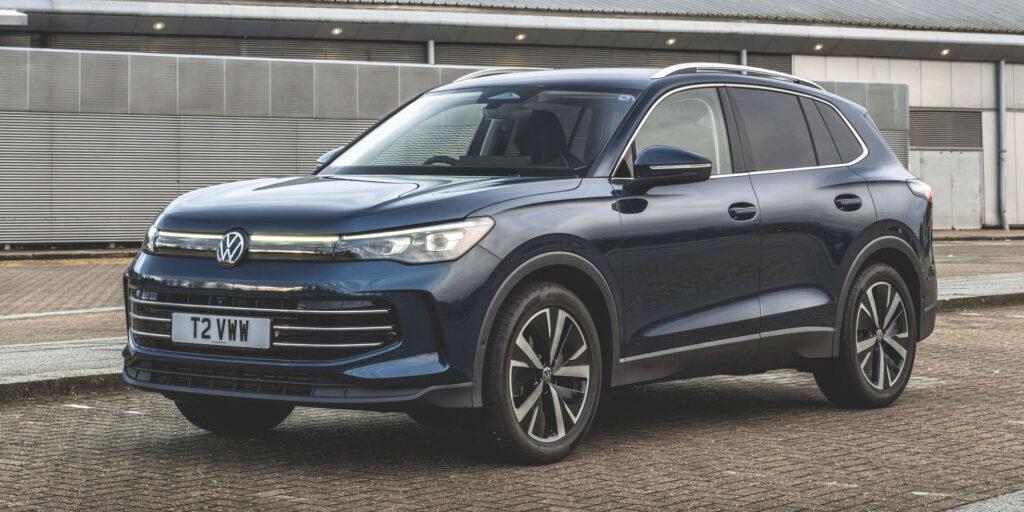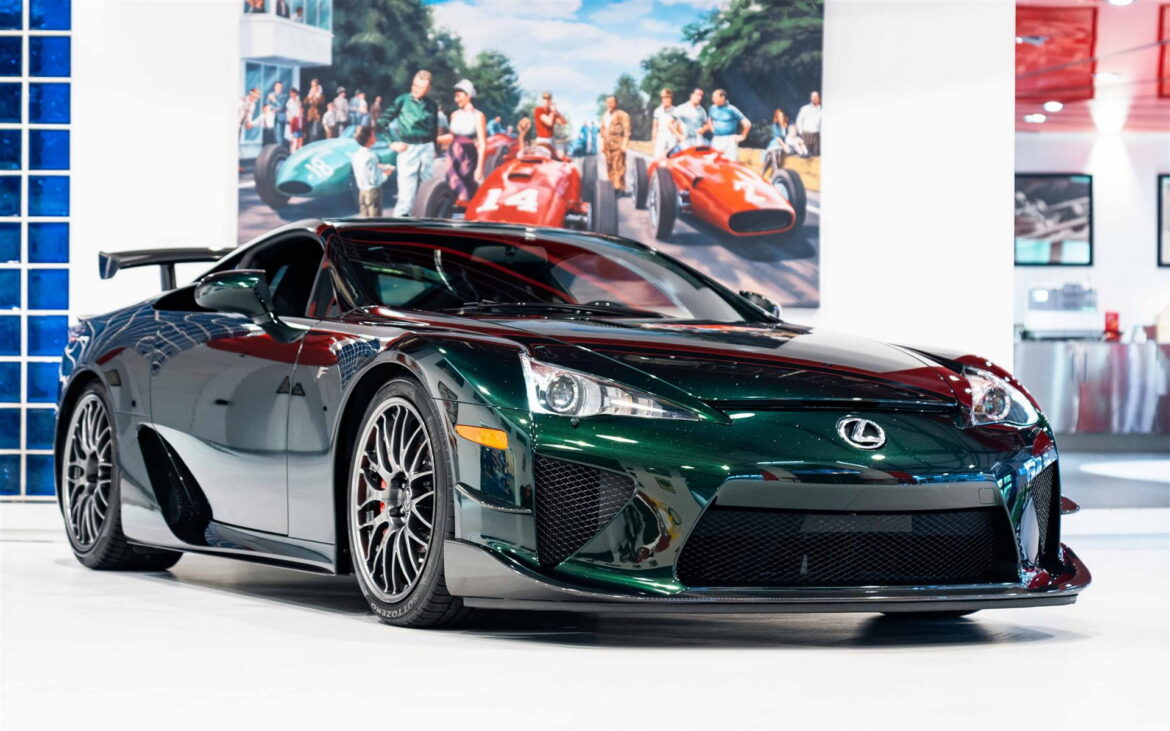 –>
–> 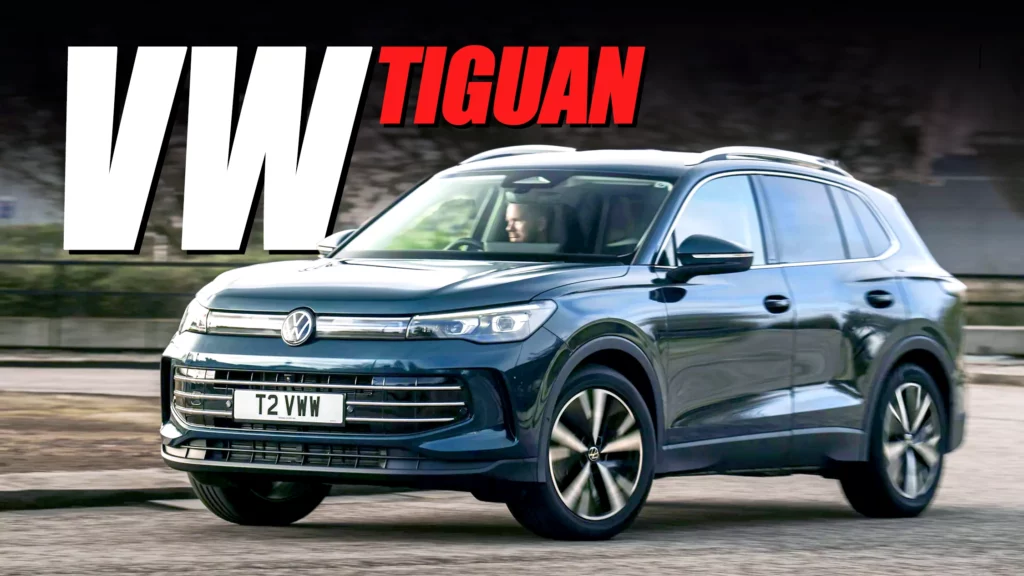
SUV was VW’s most popular vehicle globally last time around, and this one takes some important steps forward
5 hours ago
–>
The Golf turns 50 this year, and remains the best-known VW nameplate still in use. But the best-selling VW in recent years across the globe has been the Tiguan. It’s racked up 7.5 million sales since 2007 and we’ve just driven the third-generation car that intends to keep that momentum going.
Tiguan III is bigger, roomier, tech-ier, safer and more refined than the the old one, as you’d expect any new car to be. But perhaps the most important thing to know is that the Tiguan name will soon be affixed to two entirely different SUVs. Both will be offered in Europe, but only one will be available in North America.
QUICK FACTS
What’s New?
The model you see here is Europe’s direct replacement for the second-generation, five-seat Tiguan, but it won’t be stretched out to create a seven-seat successor to the old Tiguan Allspace. That role will be filled by a three-row SUV already sold in China as the Tayron, which will also become America’s new Tiguan. But both the Euro and U.S. versions of the Tayron will wear Tiguan badges for continuity’s sake.
Entry-level versions of this two-row Tiguan head into battle with mainstream small SUVs like the recently facelifted Nissan Qashqai and Kia Sportage, while more expensive variants will do their best to snatch sales away from the new BMW X1 and Mercedes GLA.
Straight lines make way for curves for 2024, and while the result isn’t unattractive, it’s arguably a little bland. Fortunately, the changes are more than skin deep. VW has upgraded the SUV to its latest MBQ Evo platform that gives it access to VW’s latest safety and infotainment tech.
Huge choice of engines – but no EV
Unless you’re dead-set on pure electric power, in which case your VW dealer will steer you towards an ID.4, the Tiguan has almost every base covered here. We drove the Tiguan in the UK where the at-launch lineup consists of two 1.5-liter mild hybrids (badged eTSi) and a 2.0-liter diesel, all three driving just the front wheels through a dual-clutch transmission. A pair of 1.5 PHEVs (again, FWD-only) land later this spring, followed by two 2.0-liter turbo petrols with AWD in the second half of the year.
UK Prices
What’s it like to drive?
The plug-ins’ incredible 70+ mile (113 km) WLTP electric range (recently upped from a predicted 62 miles / 100 km) means PHEVs will be flying out of showrooms, but that big 19 kWh battery pushes the price up, so the much more affordable eTSi we grabbed seat time in is going to be equally popular.
More: New 2024 VW Tiguan Splits From U.S. Model, PHEV Offers Huge Electric Range
Base versions make do with a miserable-sounding 128 hp (130 PS) and need 10.6 seconds to reach 62 mph (100 km/h), but our second-tier test car delivered a more respectable 148 hp (150 PS) and chopped the acceleration run to 9.1 seconds (think high eights to 60).
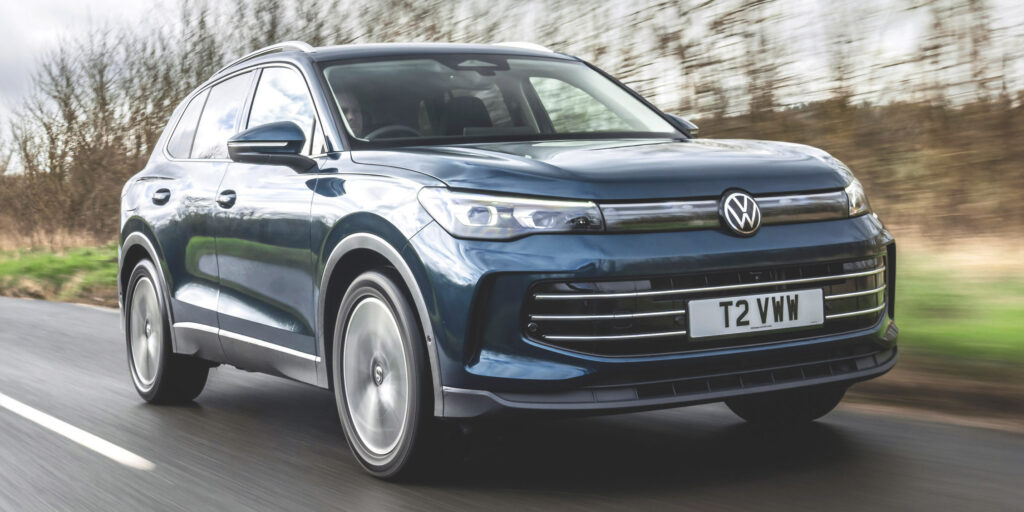
Okay even that’s not exactly rapid (the hottest PHEV does the job in 7.2 seconds), and it’s going to feel even more strained when you load up the back seats and cargo area and expect the modest 184 lb-ft (250 Nm) of torque to get you anywhere in a hurry. Coming off the line it can sometimes feel a little sluggish – blame the otherwise slick seven-speed DSG ’box – but on the move it’s a lively engine that asks to be revved, and sounds reasonably smooth when you do.
Comfort versus cornering
If you want a smooth ride to go with your smooth engine, our advice is to stick with the lower trim levels and small wheels. We tried the R-Line, which delivers a heap more visual presence thanks to its 20-inch rims and equally sporty interior, but even with its optional (£1,000 as part of the Dynamic Driving Package) adaptive dampers set to soft it was less comfortable and produced more road noise than the Tiguan Elegance on 19s (seen in these pictures). And we imagine the lower rung cars on their 17s and 18s are even cushier.
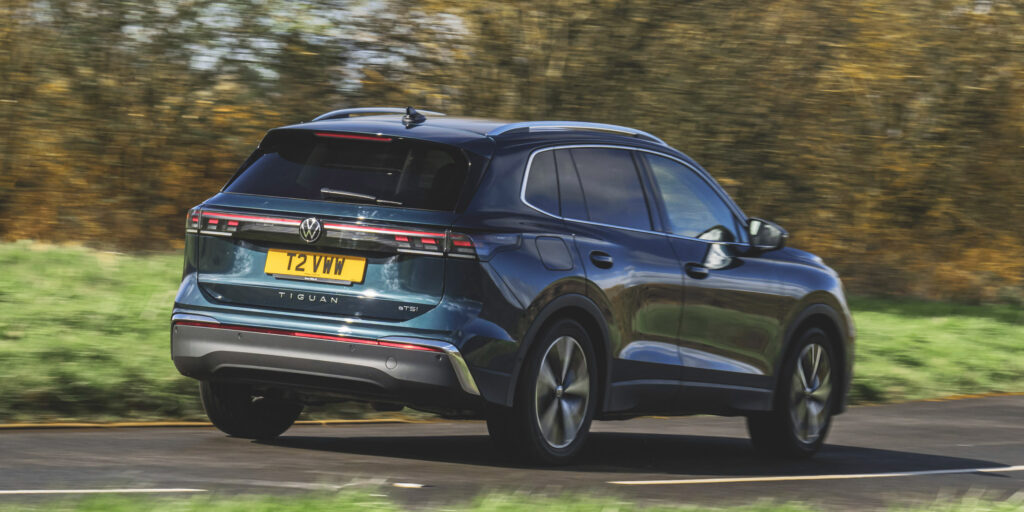
Obviously the R-Line’s trick dampers are better able to tighten up body movements when you need them to, and the fat rubber equates to higher cornering speeds, but how much hot hatch-chasing ability is the average Tiguan driver going to need?
The non-R versions ride well, steer accurately, have fine body control and are much quieter than the outgoing models. They’re the best Tiguans, though admittedly not the best-looking Tiguans.
More screen, real steering wheel buttons
The latest version of the SUV looks very different on the outside, but those exterior styling changes are nothing compared with what greets you on the other side of the door. The first thing you notice is the console screen. It’s huge. Even the lowly Tiguan, Life and Match grades get 12.9-inch displays to go with their standard 10.25-inch digital instrument packs, while higher-spec Elegance and R-Line trims enjoy an upgrade to 15 inches (shown here).
Both run VW’s latest infotainment system that places digital shortcut bars above and below the main content so you spend less time in a virtual maze looking for functions. It works well, looks great, and though we’d like to have seen some regular rotary heater controls, the temperature sliders are at least illuminated, and there are proper hard buttons on the steering wheel, not the nasty touch-sensitive junk that VW foisted on the Mk8 Golf.
AI assistant, big quality boost
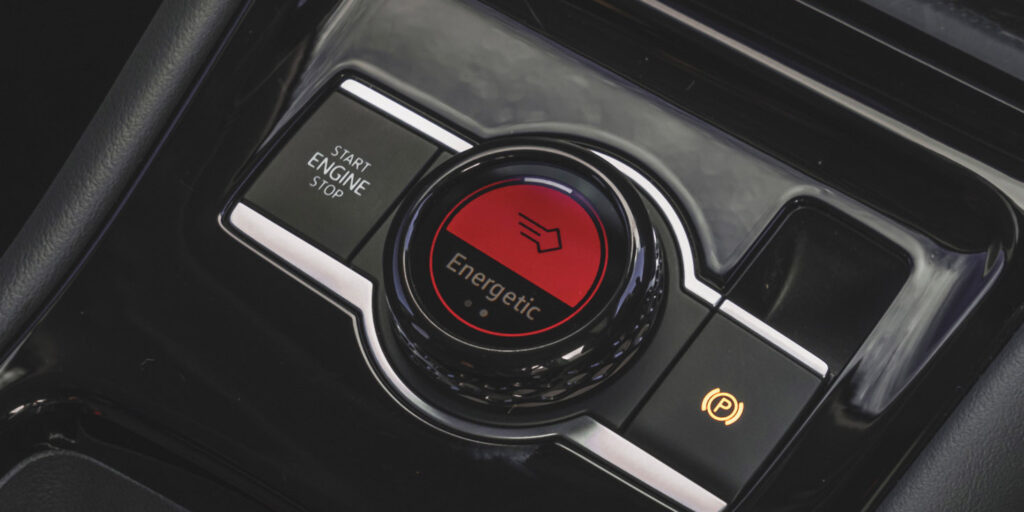
Later this spring VW will add a Chat GPT-powered voice assistant, which we’ve yet to try, and what it calls the ‘experience’ dial, that we did. Looking like a BMW iDrive controller, but more stylish and less useful, it’s basically just a glitzy volume control for the media system that can also be used to alter the driving mode and interior lighting if you tap the mini screen in its center to switch tasks.
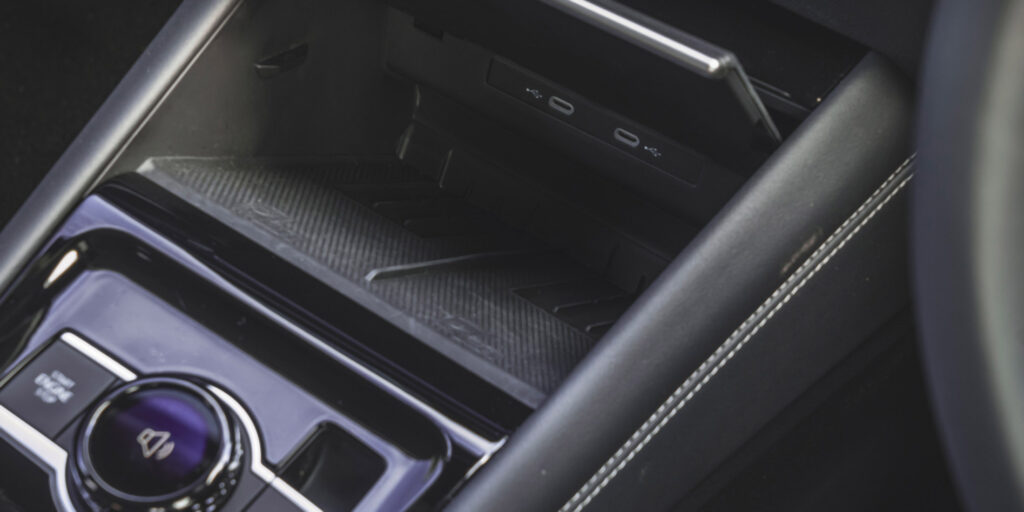
More impressive are the two clever wireless phone chargers that are hidden under a flip-up lid and chilled to save your phone from frying itself, and the big upgrade in interior quality over the old Tiguan. That second-gen Tiguan disappointed with too many hard plastics but while you’ll still find those if you try hard enough and bury your head in the footwell, from the driver’s seat the latest model looks and feels like a premium product, especially in upscale versions that feature patterned lighting on the dash and doors.
Small footprint, big space
Related: America’s 2025 VW Tiguan Takes Its R-Line For Some ’Ring-Time
Some cars use fancy screens and nice materials to distract you from glaring practical weaknesses. But the Tiguan does the useful stuff, too, and feels noticeably roomier than before despite riding on an identical 2,680 mm (105.5 inches) wheelbase. The interior is big by class standards with plenty of room for tall adults, and the flat bench means three can sit across in reasonable comfort. Those seats also slide, meaning you can cram even more luggage into an already generous 652-liter (23 cu-ft) cargo bay.
Prices and rivals
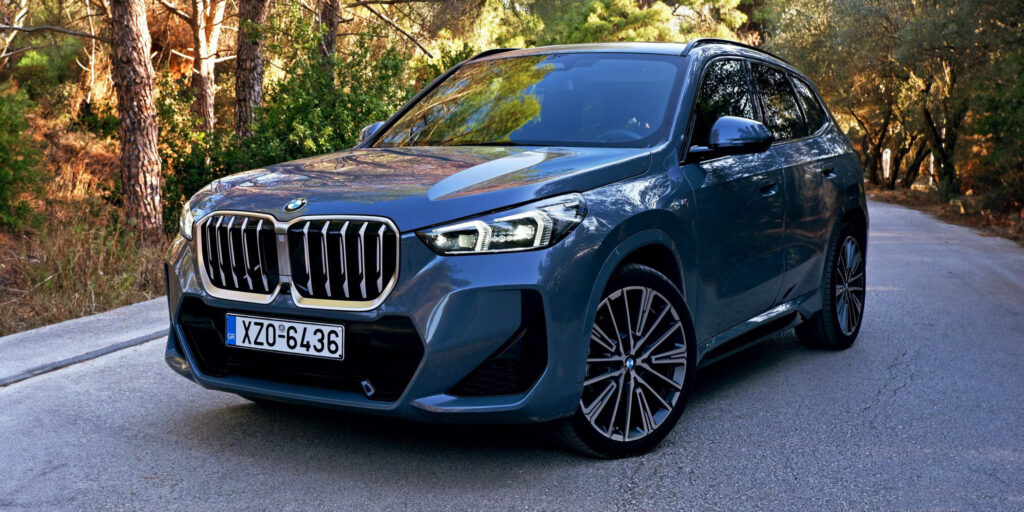
The new Tiguan is much bigger and better than the SUV it replaces, but quality comes at a cost. The entry-level 148 hp Tiguan costs £34,075 ($42,179) and does a least come with a standard DSG transmission, but you’ll need to spend £35,920 ($44,463) on a Life version, or £36,095 ($44,679) on a Match, to unlock standard adaptive cruise, phone charging and tri-zone climate, plus access to any engine option bar the 128 hp mild hybrid.
But £35k gets you into a 168 hp (170 PS) BMW X1 or a 212 hp (215 PS) Kia Sportage Hybrid (the Sportage starts at £29,330 ($36,302), but makes you row your own gears). The posh Elegance and sporty R-Line Tiguans cost £39,290 ($48,630) and £39,695 ($49,184), and that still only nets you the 148 hp mild-hybrid powertrain. If you want one of the eHybrid PHEVs you’ll need to shell out £45,500-48,220 ($56,377-59,726).
Verdict
It’s not the most dynamic-looking SUV in its class, and it’s not the sharpest to drive or the most affordable. But the Tiguan hits the right notes where it matters. It’s roomy, refined, comfortable and has a great interior in MHEV trim, and the PHEV (that we hope to try soon) builds on that with its huge electric driving range. We can’t see it being anything other than another massive hit for VW in Europe, though obviously not in America, which is still waiting to get a look at its next Tayron-based Tiguan.
